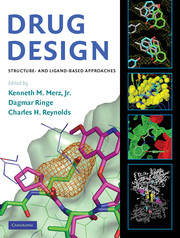Book contents
- Frontmatter
- Contents
- Contributors
- Preface
- DRUG DESIGN
- 1 Progress and issues for computationally guided lead discovery and optimization
- PART I STRUCTURAL BIOLOGY
- 2 X-ray crystallography in the service of structure-based drug design
- 3 Fragment-based structure-guided drug discovery: strategy, process, and lessons from human protein kinases
- 4 NMR in fragment-based drug discovery
- PART II COMPUTATIONAL CHEMISTRY METHODOLOGY
- PART III APPLICATIONS TO DRUG DISCOVERY
- Index
- References
4 - NMR in fragment-based drug discovery
from PART I - STRUCTURAL BIOLOGY
Published online by Cambridge University Press: 06 July 2010
- Frontmatter
- Contents
- Contributors
- Preface
- DRUG DESIGN
- 1 Progress and issues for computationally guided lead discovery and optimization
- PART I STRUCTURAL BIOLOGY
- 2 X-ray crystallography in the service of structure-based drug design
- 3 Fragment-based structure-guided drug discovery: strategy, process, and lessons from human protein kinases
- 4 NMR in fragment-based drug discovery
- PART II COMPUTATIONAL CHEMISTRY METHODOLOGY
- PART III APPLICATIONS TO DRUG DISCOVERY
- Index
- References
Summary
AN INTRODUCTION TO FRAGMENT-BASED LEAD DISCOVERY
For decades, molecular starting points for drug discovery have been found by screening large numbers of natural and synthetic compounds for biological activity in phenotypic and biochemical assays. Then, beginning in the mid to late 1990s, several pharmaceutical groups developed new approaches [such as structure/activity relationship by nuclear magnetic resonance (SAR by NMR), the SHAPES strategy, and needle screening] in which simple, low-molecular-weight compounds were screened for binding to the target of interest, and these relatively weak binding molecules were then used to systematically construct larger, more potent, drug leads. Such small screening molecules are now commonly called fragments and the related processes collectively called fragment-based lead discovery (FBLD).
NMR was the first experimental method used to screen fragments, and although a variety of other techniques (including x-ray crystallography, surface plasmon resonance, high concentration bioassays, and mass spectroscopy) have also been applied, NMR is still the most widely used. This chapter reviews the use of NMR for FBLD, beginning with an explanation of the principles behind fragment screening. NMR screening methods are then described, followed by a series of examples that illustrate the process through which fragment screening hits are converted into leads.
- Type
- Chapter
- Information
- Drug DesignStructure- and Ligand-Based Approaches, pp. 41 - 58Publisher: Cambridge University PressPrint publication year: 2010
References
- 2
- Cited by



